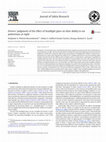Papers by Ashley Stafford

PsycEXTRA Dataset, 2000
Introduction: Several studies have concluded that pedestrians typically overestimate their own co... more Introduction: Several studies have concluded that pedestrians typically overestimate their own conspicuity to approaching drivers at night. The present experiments extended this research by exploring the accuracy of drivers' judgments of pedestrian conspicuity while facing varying degrees of headlight glare. Method: In Experiment 1, participants on an open road estimated their ability to see a roadside pedestrian in each of two clothing configurations and with each of three different glare intensities present. In Experiment 2, participants responded to a roadside pedestrian under the same open road conditions; the participants were naïve with regard to both the position of the pedestrian and to the clothing and glare manipulations. Results: Consistent with earlier research, estimates of response distance were, on the average, over three times greater than actual recognition distance. The extent to which participants overestimated conspicuity was greater when the pedestrian wore a retroreflective vest, and participants incorrectly judged that headlight glare would not degrade drivers' ability to see a pedestrian wearing a retroreflective vest. Conclusions and Practical Applications: These results confirm that road users' understanding of issues involving drivers' night vision is limited. These misunderstandings may result in road users behaving in ways that increase the risk of nighttime collisions with pedestrians.








Uploads
Papers by Ashley Stafford